TOYOTA GR86 2022 Owners Manual (in English)
Manufacturer: TOYOTA, Model Year: 2022, Model line: GR86, Model: TOYOTA GR86 2022Pages: 582, PDF Size: 86.38 MB
Page 181 of 582

179
4
4-5. EyeSight
Driving
WA R N I N G
*1: The wheels and tires have func-
tions that are critically important.
Be sure to use the correct ones.
( P.375)
*2: If the brake system warning light
(red) does not turn off, immediately
pull the vehicle over in a safe place
and contact any authorized Toyota
retailer or Toyota authorized
repairer, or any reliable repairer to
have the system inspected.
*3: For details about the meter, refer to
P. 8 8 .
NOTICE
In the following situations, turn off
Pre-Collision Braking System. Other- wise Pre-Collision Braking System
may activate unexpectedly.
●The vehicle is being towed.
●The vehicle is being loaded onto a
carrier.
●A chassis dynamometer, free-roll-
ers or similar equipment is being used.
●A mechanic lifts up the vehicle, starts the engine and spins the
wheels freely.
●Passing hanging banners, flags or
branches
●Thick/tall vegetation is touching the
vehicle.
●Driving on a race track
●In a drive-through car wash
Pre-Collision Braking System may
activate in the following situations. Therefore concentrate on safe driv-
ing.
●Passing through an automatic gate
(opening and shutting)
●Driving close to the vehicle in front
●Driving in a location where the grade of the road changes rapidly
●Visibility is poor due to sand, smoke
or water vapor blowing in the wind,
or the front vision is obscured due to water splashes, snow, dirt or dust
stir up generated by the vehicle in
front or oncoming traffic.
●Passing through clouds of steam or
smoke, etc.
●In adverse weather, such as heavy
snow or snowstorms
Page 182 of 582
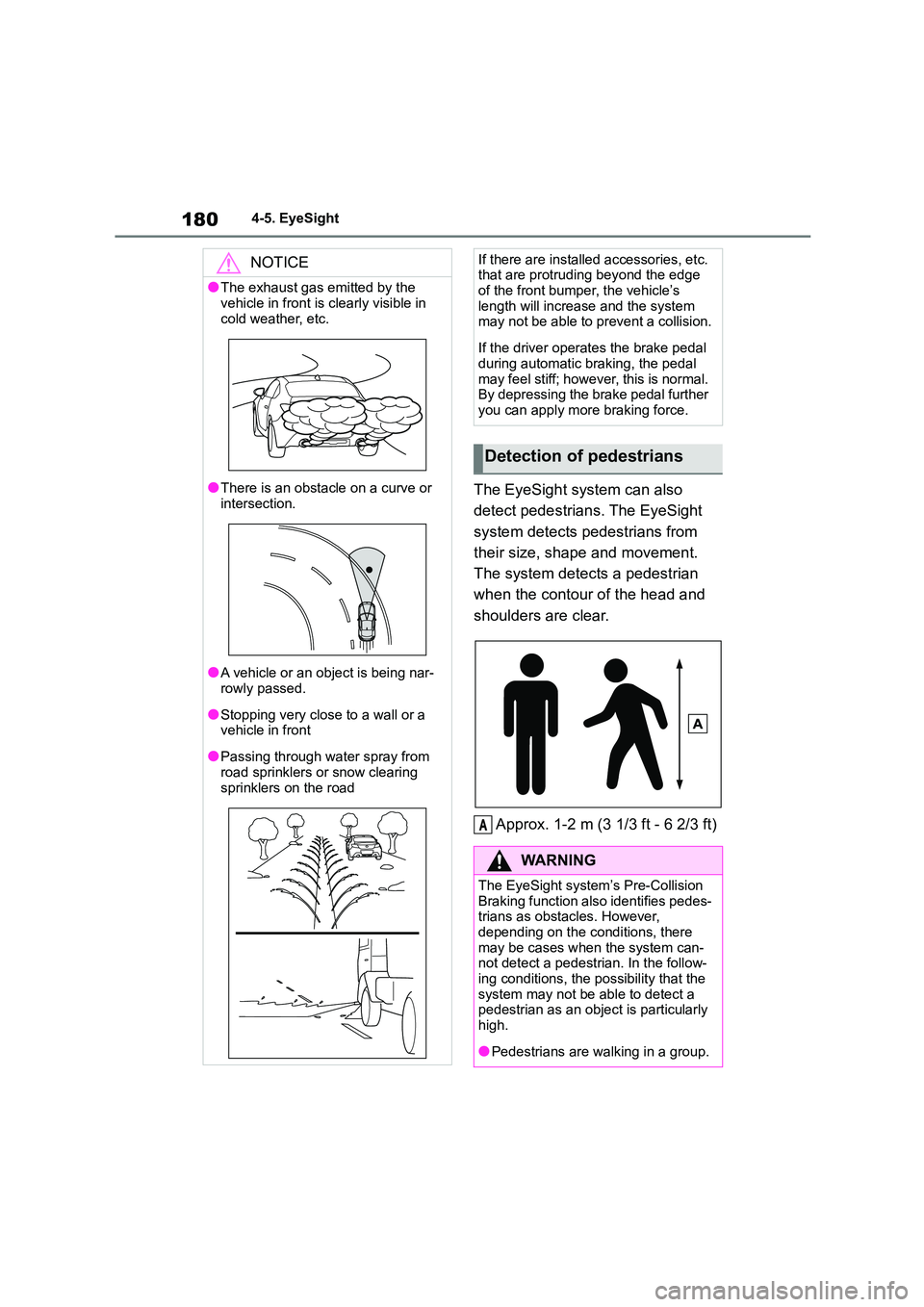
1804-5. EyeSight
The EyeSight system can also
detect pedestrians. The EyeSight
system detects pedestrians from
their size, shape and movement.
The system detects a pedestrian
when the contour of the head and
shoulders are clear.
Approx. 1-2 m (3 1/3 ft - 6 2/3 ft)
NOTICE
●The exhaust gas emitted by the
vehicle in front is clearly visible in
cold weather, etc.
●There is an obstacle on a curve or
intersection.
●A vehicle or an object is being nar-
rowly passed.
●Stopping very close to a wall or a
vehicle in front
●Passing through water spray from
road sprinklers or snow clearing
sprinklers on the road
If there are installed accessories, etc. that are protruding beyond the edge
of the front bumper, the vehicle’s
length will increase and the system may not be able to prevent a collision.
If the driver operates the brake pedal during automatic braking, the pedal
may feel stiff; however, this is normal.
By depressing the brake pedal further you can apply more braking force.
Detection of pedestrians
WA R N I N G
The EyeSight system ’s Pre-Collision
Braking function also identifies pedes-
trians as obstacles. However, depending on the conditions, there
may be cases when the system can-
not detect a pedestrian. In the follow- ing conditions, the possibility that the
system may not be able to detect a
pedestrian as an object is particularly high.
●Pedestrians are walking in a group.
A
Page 183 of 582
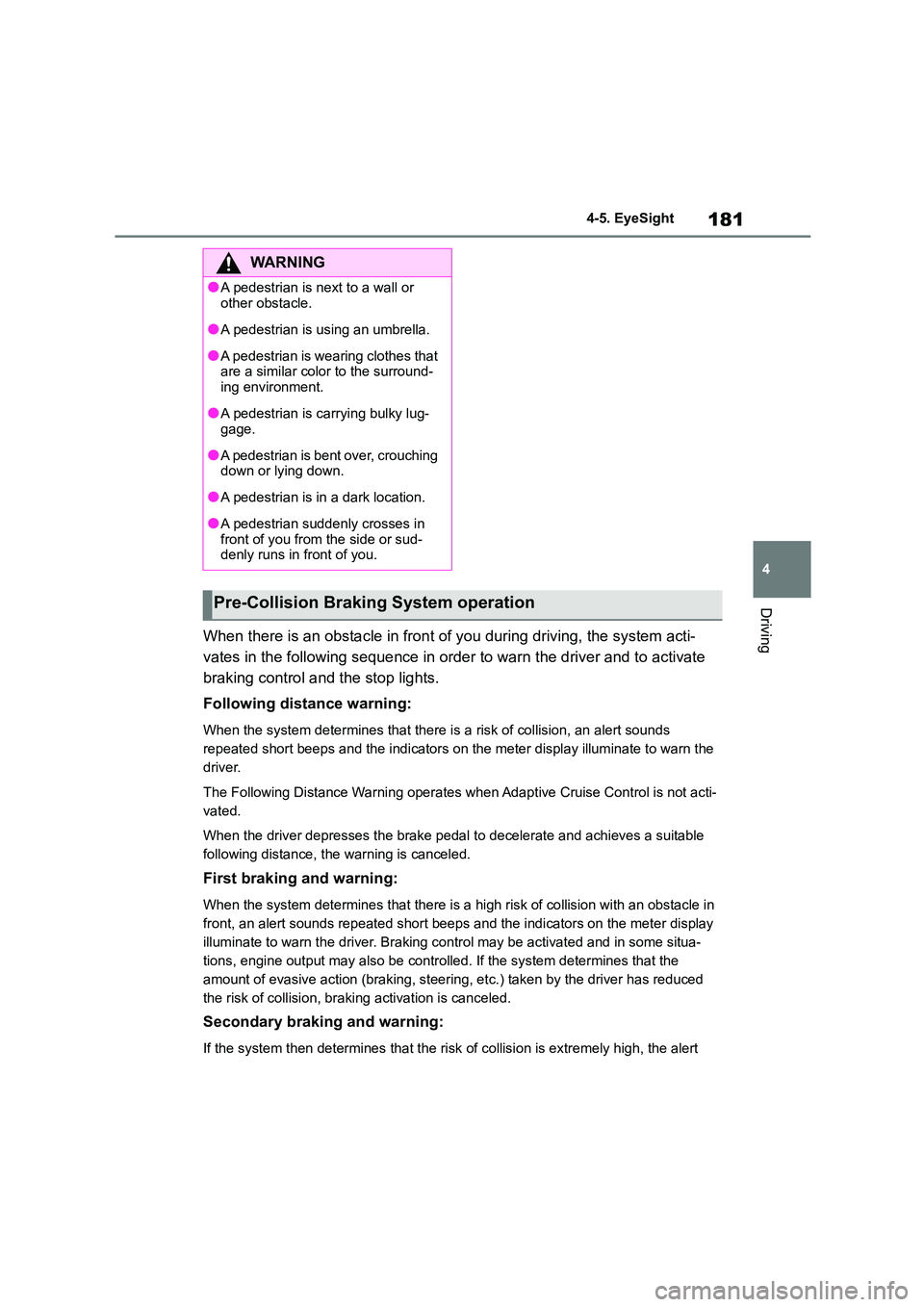
181
4
4-5. EyeSight
Driving
When there is an obstacle in front of you during driving, the system acti-
vates in the following sequence in order to warn the driver and to activate
braking control and the stop lights.
Following distance warning:
When the system determines that there is a risk of collision, an alert sounds
repeated short beeps and the indicators on the meter display illuminate to warn the
driver.
The Following Distance Warning operates when Adaptive Cruise Control is not acti-
vated.
When the driver depresses the brake pedal to decelerate and achieves a suitable
following distance, the warning is canceled.
First braking and warning:
When the system determines that there is a high risk of collision with an obstacle in
front, an alert sounds repeated short beeps and the indicators on the meter display
illuminate to warn the driver. Braking control may be activated and in some situa-
tions, engine output may also be controlled. If the system determines that the
amount of evasive action (braking, steering, etc.) taken by the driver has reduced
the risk of collision, braking activation is canceled.
Secondary braking and warning:
If the system then determines that the risk of collision is extremely high, the alert
WA R N I N G
●A pedestrian is next to a wall or
other obstacle.
●A pedestrian is using an umbrella.
●A pedestrian is wearing clothes that are a similar color to the surround-
ing environment.
●A pedestrian is carrying bulky lug- gage.
●A pedestrian is bent over, crouching down or lying down.
●A pedestrian is in a dark location.
●A pedestrian suddenly crosses in
front of you from the side or sud- denly runs in front of you.
Pre-Collision Braking System operation
Page 184 of 582
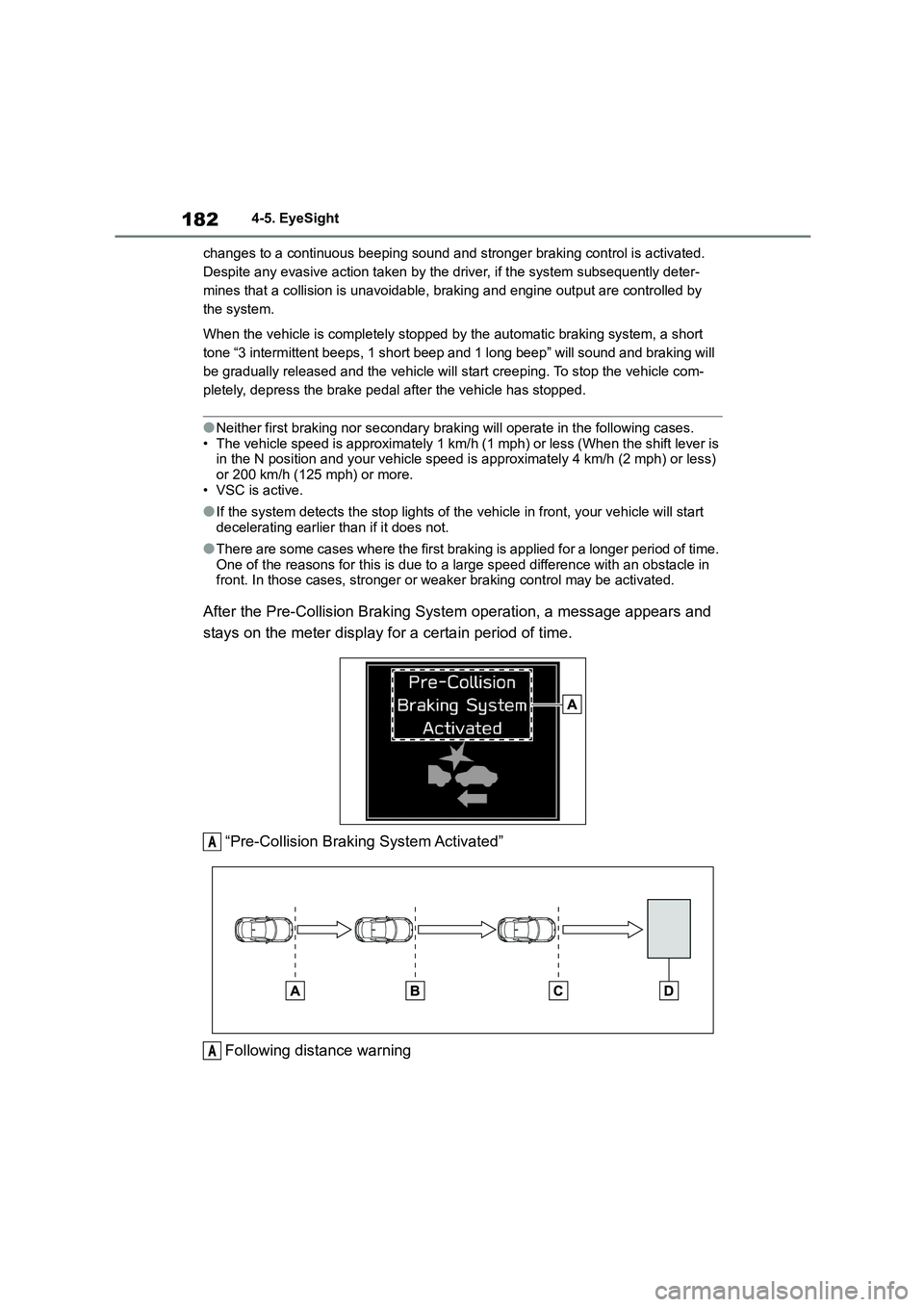
1824-5. EyeSight
changes to a continuous beeping sound and stronger braking control is activated.
Despite any evasive action ta ken by the driver, if the system subsequently deter-
mines that a collision is unavoidable, braking and engine output are controlled by
the system.
When the vehicle is comple tely stopped by the automatic braking system, a short
tone “3 intermittent beeps, 1 short beep and 1 long beep” will sound and braking will
be gradually released and the vehicle will start creeping. To stop the vehicle com-
pletely, depress the brake pedal after the vehicle has stopped.
●Neither first braking nor secondary brak ing will operate in the following cases.
• The vehicle speed is approximately 1 km/h (1 mph) or less (When the shift lever is in the N position and your vehicle speed is approximately 4 km/h (2 mph) or less)
or 200 km/h (125 mph) or more.
• VSC is active.
●If the system detects th e stop lights of the vehicle in front, your vehicle will start
decelerating earlier than if it does not.
●There are some cases where the first braking is applied for a longer period of time.
One of the reasons for this is due to a large speed difference with an obstacle in front. In those cases, stronger or weaker braking control may be activated.
After the Pre-Collision Braking System operation, a message appears and
stays on the meter display for a certain period of time.
“Pre-Collision Braking System Activated”
Following dist ance warning
A
A
Page 185 of 582
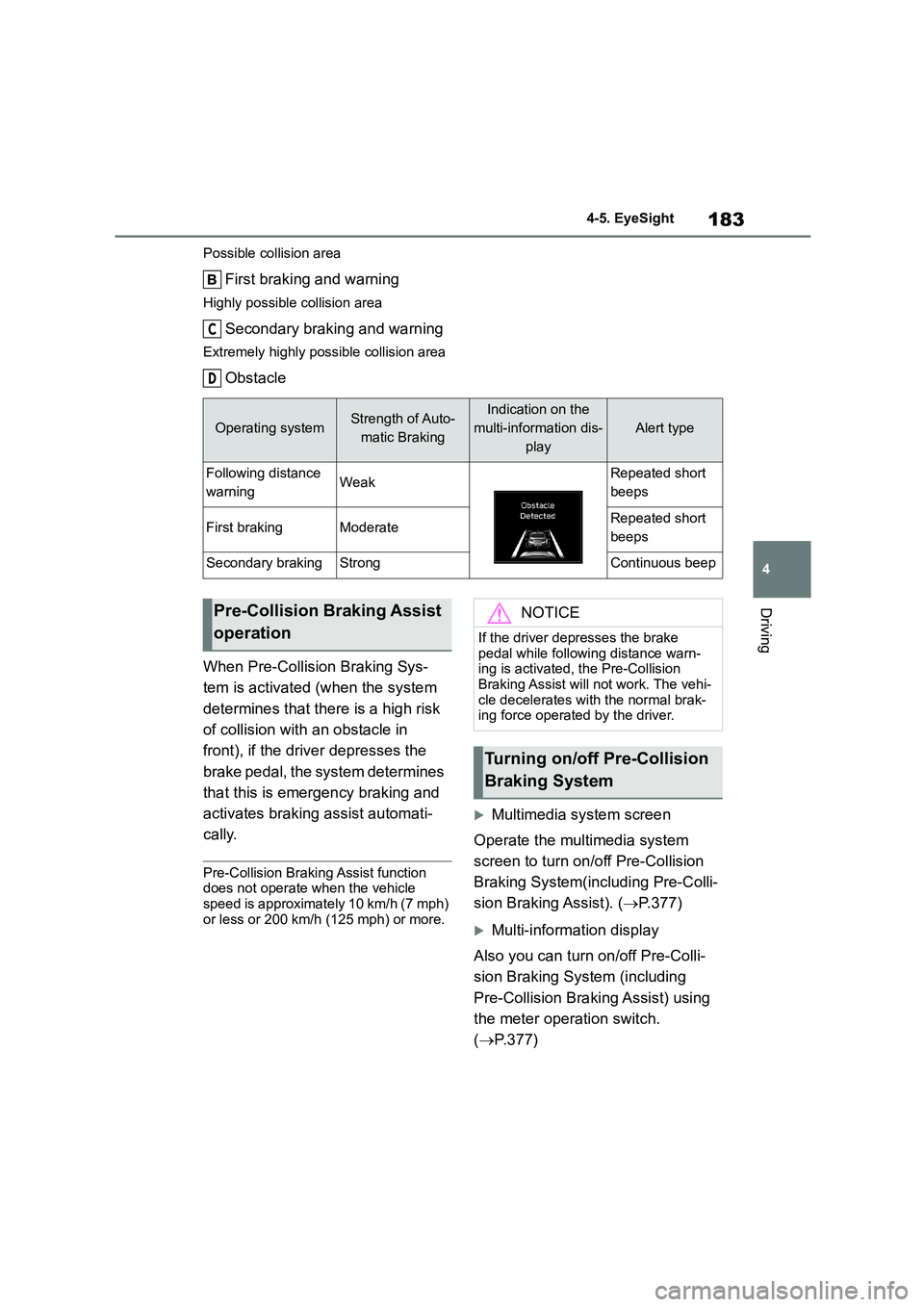
183
4
4-5. EyeSight
Driving
Possible collision area
First braking and warning
Highly possible collision area
Secondary braking and warning
Extremely highly possible collision area
Obstacle
When Pre-Collision Braking Sys-
tem is activated (when the system
determines that there is a high risk
of collision with an obstacle in
front), if the driver depresses the
brake pedal, the system determines
that this is emergency braking and
activates braking assist automati-
cally.
Pre-Collision Braking Assist function
does not operate when the vehicle
speed is approximately 10 km/h (7 mph) or less or 200 km/h (125 mph) or more.
Multimedia system screen
Operate the multimedia system
screen to turn on /off Pre-Collision
Braking System(inc luding Pre-Colli-
sion Braking Assist). ( P.377)
Multi-information display
Also you can turn on/off Pre-Colli-
sion Braking System (including
Pre-Collision Braking Assist) using
the meter operation switch.
( P. 3 7 7 )
Operating systemStrength of Auto-
matic Braking
Indication on the
multi-information dis-
play
Alert type
Following distance
warningWeakRepeated short
beeps
First brakingModerateRepeated short
beeps
Secondary brakingStrongContinuous beep
C
D
Pre-Collision Braking Assist
operation
NOTICE
If the driver depresses the brake
pedal while following distance warn- ing is activated, the Pre-Collision
Braking Assist will not work. The vehi-
cle decelerates with the normal brak- ing force operated by the driver.
Turning on/off Pre-Collision
Braking System
Page 186 of 582
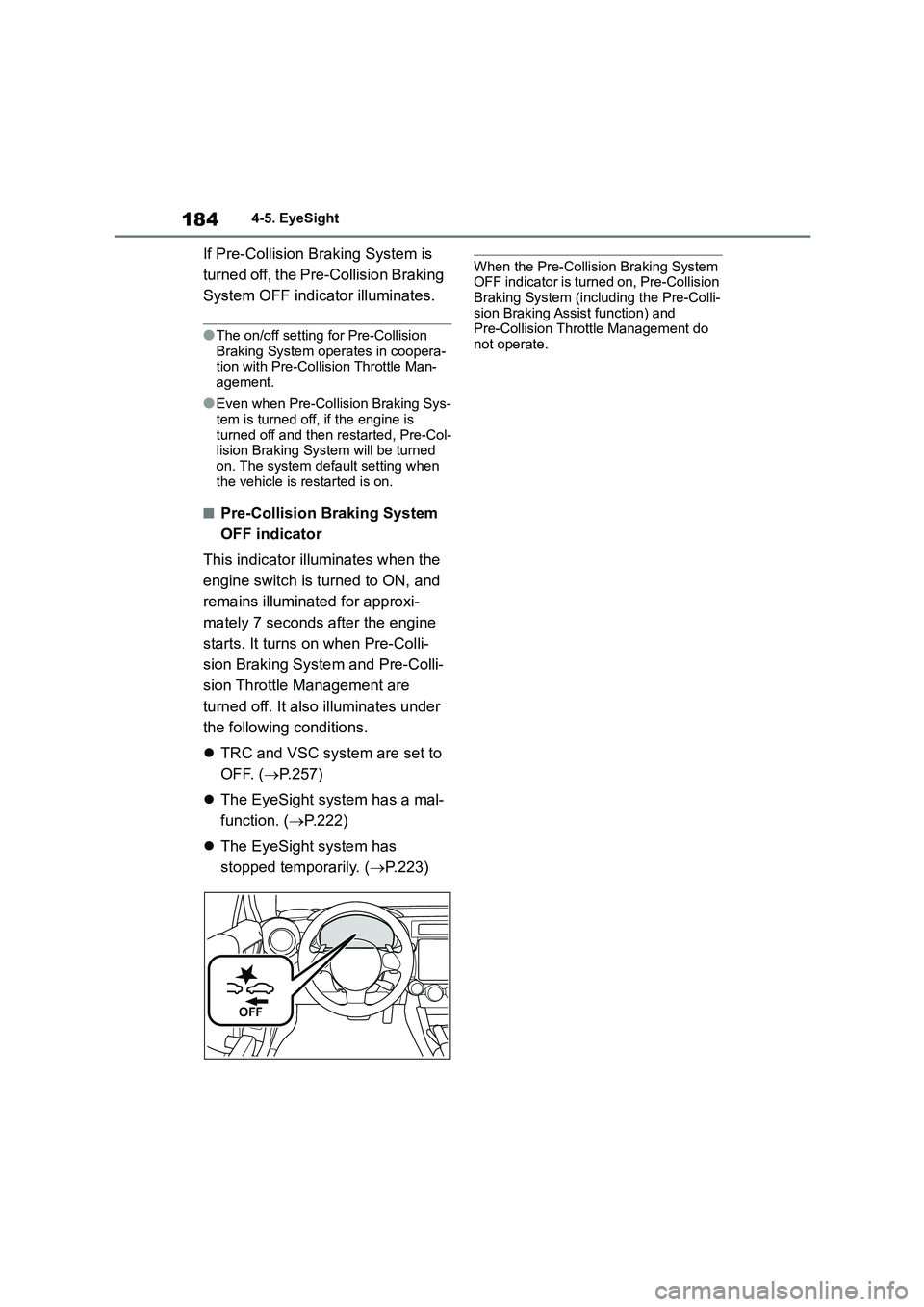
1844-5. EyeSight
If Pre-Collision Braking System is
turned off, the Pre-Collision Braking
System OFF indicator illuminates.
●The on/off setting for Pre-Collision
Braking System operates in coopera-
tion with Pre-Collision Throttle Man- agement.
●Even when Pre-Collision Braking Sys-tem is turned off, if the engine is
turned off and then restarted, Pre-Col-
lision Braking System will be turned on. The system default setting when
the vehicle is restarted is on.
■Pre-Collision Braking System
OFF indicator
This indicator illuminates when the
engine switch is turned to ON, and
remains illuminated for approxi-
mately 7 seconds after the engine
starts. It turns on when Pre-Colli-
sion Braking System and Pre-Colli-
sion Throttle Management are
turned off. It also illuminates under
the following conditions.
TRC and VSC system are set to
OFF. ( P.257)
The EyeSight system has a mal-
function. ( P.222)
The EyeSight system has
stopped temporarily. ( P.223)
When the Pre-Collision Braking System OFF indicator is turned on, Pre-Collision
Braking System (including the Pre-Colli-
sion Braking Assist function) and Pre-Collision Throttle Management do
not operate.
Page 187 of 582

185
4
4-5. EyeSight
Driving
*: If equipped
Adaptive Cruise Control*
Adaptive Cruise Control is a
driving support system
intended to allow more com-
fortable driving on express-
ways, freeways and
motorways. The stereo cam-
era detects vehicles in front
that are driving in the same
traffic lane, and your vehicle
follows the vehicle in front (up
to the maximum speed of the
set vehicle speed). While fol-
lowing, your vehicle will auto-
matically maintain a following
distance that corresponds to
the speed of the vehicle in
front. The vehicle is capable of
being controlled at a speed
between 0 km/h (0 mph) and
approximately 180 km/h (110
mph). Please remember that
you should not exceed posted
speed limits.
WA R N I N G
●This system does not provide the
driver with an automatic driving
function that handles all traffic con- ditions.
●Do not rely excessively on Adaptive Cruise Control. Th is system is not
intended to assist in driving when
the driver is not paying full attention to what is ahead of him/her due to
distractions or a lack of concentra-
tion while driving, or under condi- tions of poor visibility. It is not
intended to prevent rear-end colli-
sions. Strive for safe driving at all times.
Always maintain a safe following
distance behind the vehicle in front of you, pay attention to your
surroundings and the driving condi-
tions, and operate the brake pedal and take other actions as neces-
sary.
●When using Adaptive Cruise Con-
trol, always set the speed according
to the speed limit, traffic flow, road conditions, and other conditions.
●Before using the system, perform a daily inspection and verify that
there are no malfunctions of the
tires or brakes.
●When you do not want to use Adap-
tive Cruise Control, be sure to turn it off by pressing the “ON-OFF”
switch. If the switch is left on, cruise
control may be accidentally engaged, possibly resulting in an
accident.
●Before using Adaptive Cruise Con-
trol, be sure to full y verify the safety
of the vehicle occupants and the area around the vehicle. Never
operate the cruise control from out-
side the vehicle.
The system may not operate correctly
under the conditions listed below.
When these conditions occur, do not use Adaptive Cruise Control.
●The tire pressure is not correct.*1
Page 188 of 582
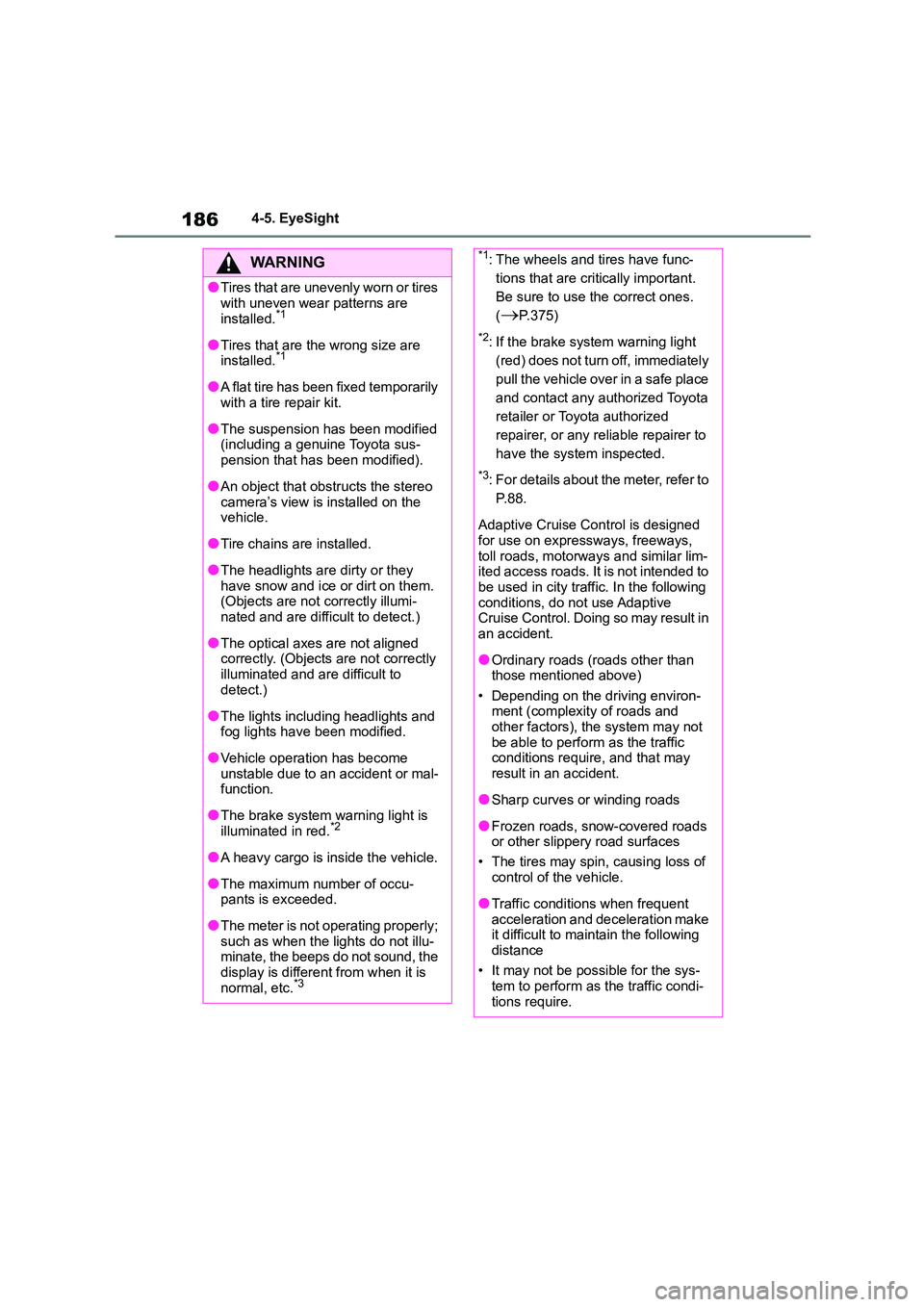
1864-5. EyeSight
WA R N I N G
●Tires that are unevenly worn or tires
with uneven wear patterns are
installed.*1
●Tires that are the wrong size are
installed.*1
●A flat tire has been fixed temporarily
with a tire repair kit.
●The suspension has been modified
(including a genuine Toyota sus-
pension that has been modified).
●An object that ob structs the stereo
camera’s view is installed on the vehicle.
●Tire chains are installed.
●The headlights are dirty or they
have snow and ice or dirt on them. (Objects are not correctly illumi-
nated and are difficult to detect.)
●The optical axes are not aligned
correctly. (Objects are not correctly
illuminated and are difficult to detect.)
●The lights including headlights and fog lights have been modified.
●Vehicle operation has become unstable due to an accident or mal-
function.
●The brake system warning light is
illuminated in red.*2
●A heavy cargo is inside the vehicle.
●The maximum num ber of occu- pants is exceeded.
●The meter is not operating properly; such as when the lights do not illu-
minate, the beeps do not sound, the
display is different from when it is normal, etc.*3
*1: The wheels and tires have func-
tions that are critically important.
Be sure to use the correct ones.
(P.375)
*2: If the brake system warning light
(red) does not turn off, immediately
pull the vehicle over in a safe place
and contact any authorized Toyota
retailer or Toyota authorized
repairer, or any reliable repairer to
have the system inspected.
*3: For details about the meter, refer to
P.88.
Adaptive Cruise Control is designed for use on expressways, freeways,
toll roads, motorways and similar lim-
ited access roads. It is not intended to be used in city traffic. In the following
conditions, do not use Adaptive
Cruise Control. Doin g so may result in an accident.
●Ordinary roads (roads other than those mentioned above)
• Depending on the driving environ-
ment (complexity of roads and other factors), the system may not
be able to perform as the traffic
conditions require, and that may result in an accident.
●Sharp curves or winding roads
●Frozen roads, snow-covered roads
or other slippery road surfaces
• The tires may spin, causing loss of
control of the vehicle.
●Traffic conditions when frequent
acceleration and deceleration make
it difficult to maintain the following
distance
• It may not be possible for the sys-
tem to perform as the traffic condi-
tions require.
Page 189 of 582
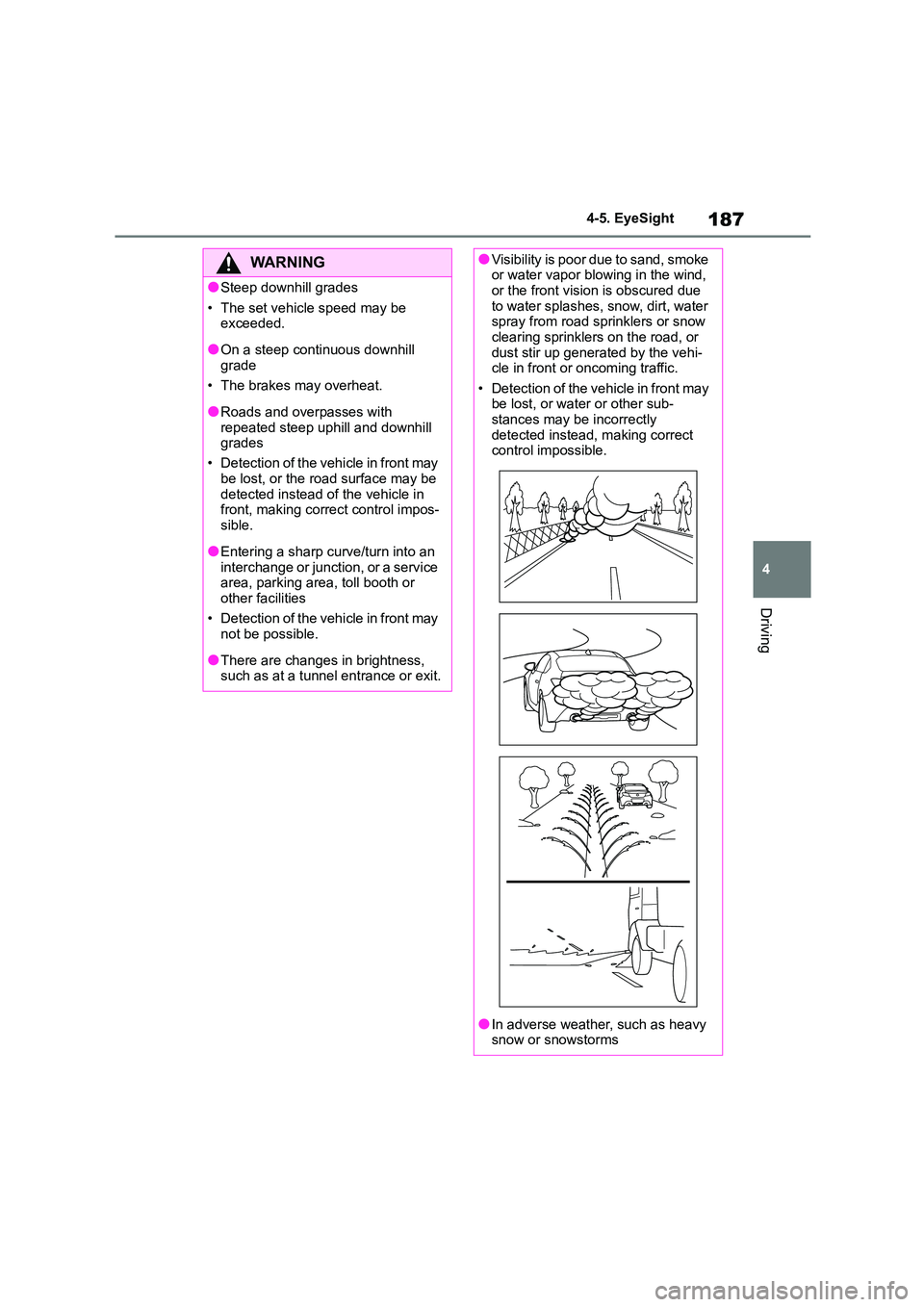
187
4
4-5. EyeSight
Driving
WA R N I N G
●Steep downhill grades
• The set vehicle speed may be
exceeded.
●On a steep continuous downhill
grade
• The brakes may overheat.
●Roads and overpasses with
repeated steep uphill and downhill grades
• Detection of the vehicle in front may
be lost, or the road surface may be detected instead of the vehicle in
front, making correct control impos-
sible.
●Entering a sharp curve/turn into an
interchange or junction, or a service area, parking area, toll booth or
other facilities
• Detection of the vehicle in front may not be possible.
●There are changes in brightness, such as at a tunnel entrance or exit.
●Visibility is poor due to sand, smoke or water vapor blowing in the wind,
or the front vision is obscured due
to water splashes, snow, dirt, water spray from road sprinklers or snow
clearing sprinklers on the road, or
dust stir up generated by the vehi- cle in front or oncoming traffic.
• Detection of the vehicle in front may
be lost, or water or other sub- stances may be incorrectly
detected instead, making correct
control impossible.
●In adverse weather, such as heavy snow or snowstorms
Page 190 of 582
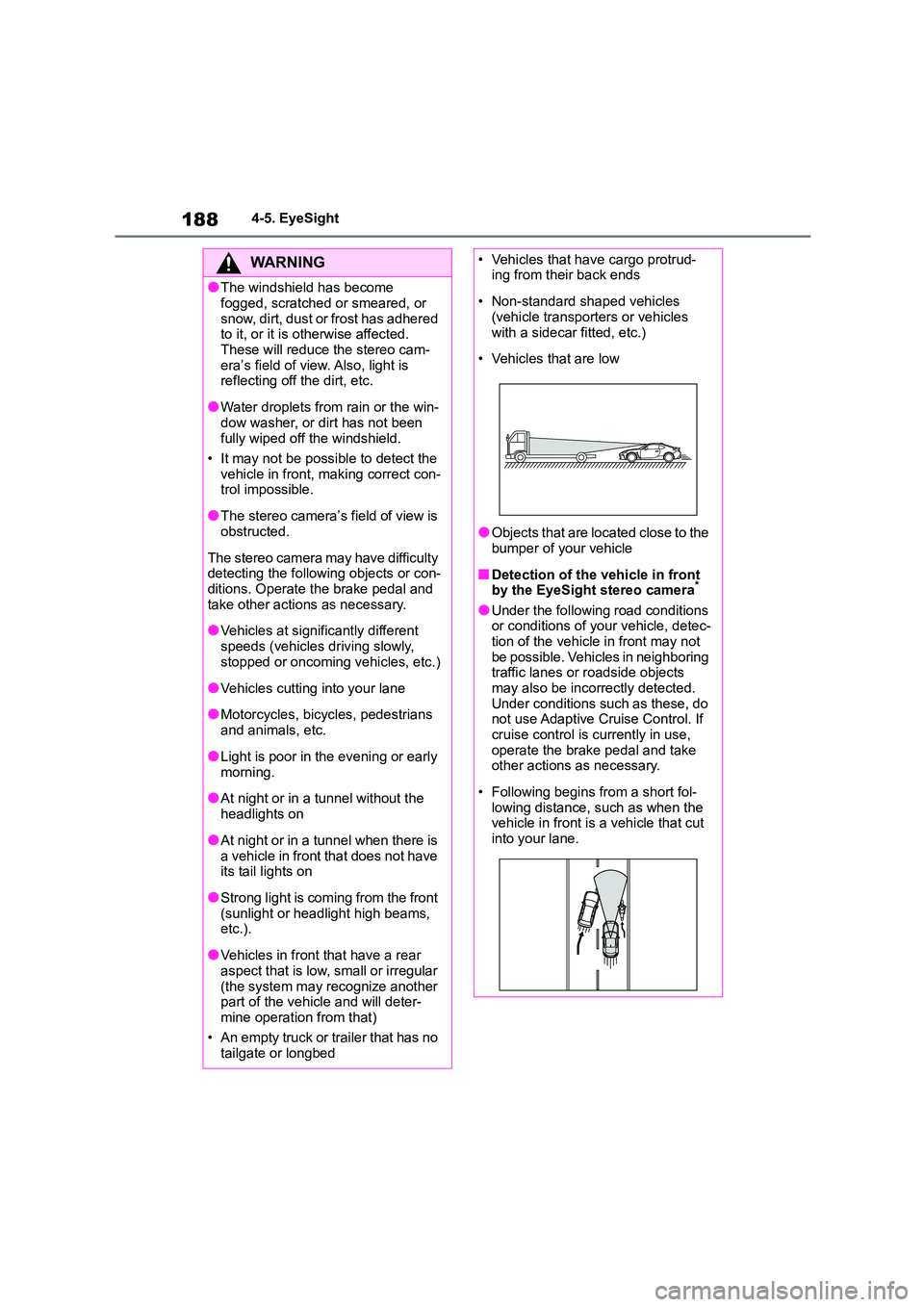
1884-5. EyeSight
WA R N I N G
●The windshield has become
fogged, scratched or smeared, or
snow, dirt, dust or frost has adhered to it, or it is otherwise affected.
These will reduce the stereo cam-
era’s field of view. Also, light is reflecting off the dirt, etc.
●Water droplets from rain or the win-
dow washer, or dirt has not been fully wiped off the windshield.
• It may not be possible to detect the
vehicle in front, making correct con- trol impossible.
●The stereo camera’s field of view is obstructed.
The stereo camera may have difficulty detecting the following objects or con-
ditions. Operate the brake pedal and
take other actions as necessary.
●Vehicles at significantly different
speeds (vehicles driving slowly, stopped or oncoming vehicles, etc.)
●Vehicles cutting into your lane
●Motorcycles, bicycles, pedestrians
and animals, etc.
●Light is poor in the evening or early
morning.
●At night or in a tunnel without the
headlights on
●At night or in a tunnel when there is
a vehicle in front that does not have its tail lights on
●Strong light is coming from the front (sunlight or headlight high beams,
etc.).
●Vehicles in front that have a rear
aspect that is low, small or irregular
(the system may re cognize another part of the vehicle and will deter-
mine operation from that)
• An empty truck or trailer that has no tailgate or longbed
• Vehicles that have cargo protrud-ing from their back ends
• Non-standard shaped vehicles (vehicle transporters or vehicles
with a sidecar fitted, etc.)
• Vehicles that are low
●Objects that are located close to the bumper of your vehicle
■Detection of the vehicle in front by the EyeSight stereo camera*
●Under the following road conditions
or conditions of your vehicle, detec- tion of the vehicle in front may not
be possible. Vehicles in neighboring
traffic lanes or roadside objects may also be inco rrectly detected.
Under conditions such as these, do
not use Adaptive Cruise Control. If cruise control is currently in use,
operate the brake pedal and take
other actions as necessary.
• Following begins from a short fol-
lowing distance, such as when the vehicle in front is a vehicle that cut
into your lane.